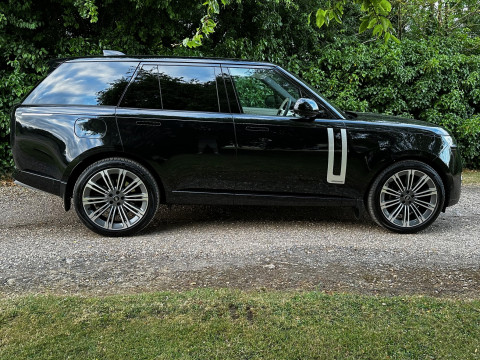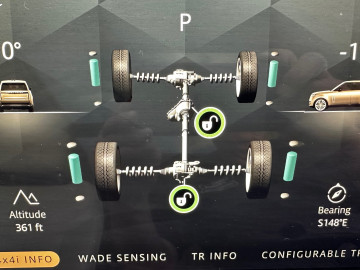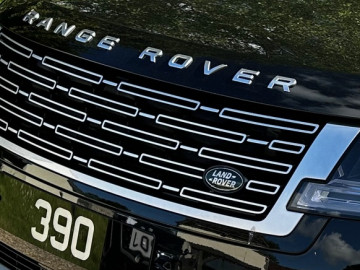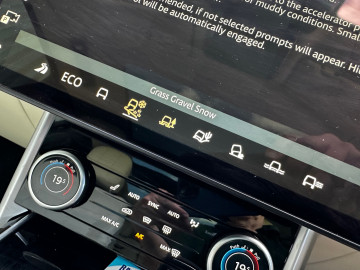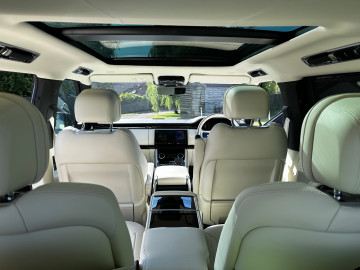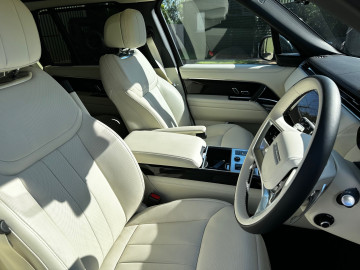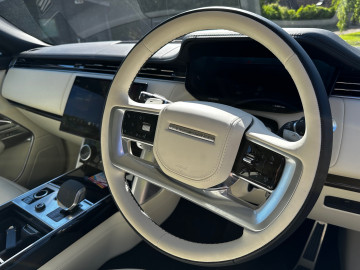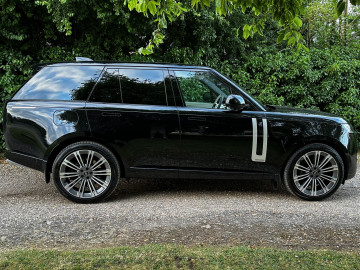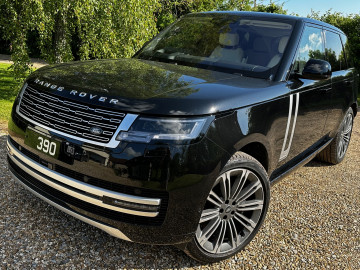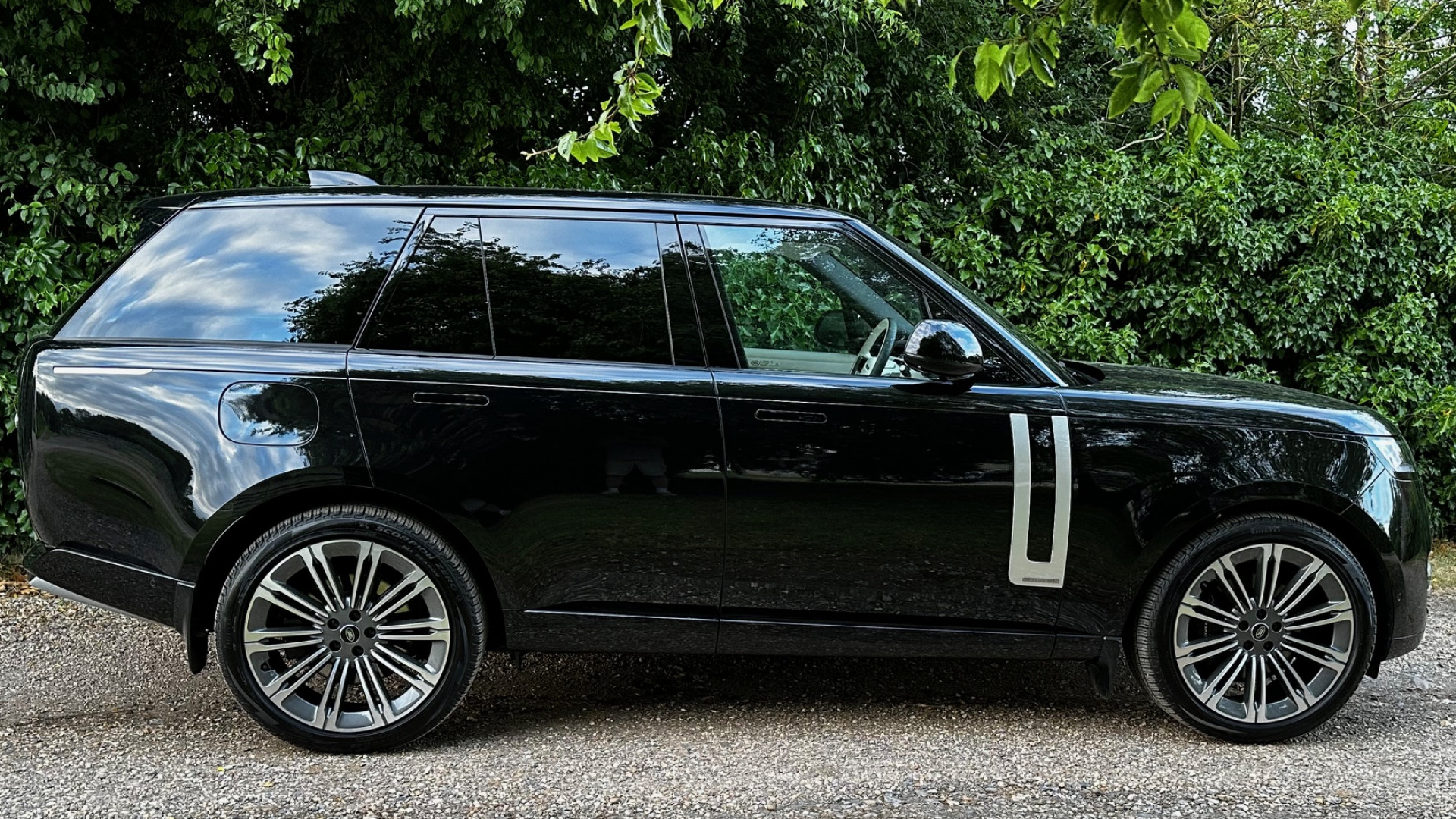
The Range Rover re-imagined
Range Rover: L460 - V8 Petrol Autobiography (2023)
Our most current Range Rover is clearly recognisable as the 5th generation Range Rover (L460). It is an (almost) regular SWB 2023 Autobiography model with the top spec 530hp BMW 4.4Ltr V8 twin turbocharged petrol engine. Perhaps the last opportunity to enjoy this energy hungry power unit before the world shouts “foul” over gratuitous burning of fossil fuels. Costing a king’s ransom this is nevertheless only mid-range. With LWB, 7 seater and, ultra luxury, SV models sitting above it, adding a further potential £50,000 to £70,000 to the already weighty £130,000 (2023) list price. Some things remain unchanged. This vehicle still stands aloft as LR’s flagship model. It remains the most capable means of taking lounge seats up mountains, across ice caps and through raging rivers. And every interior surface is covered in either leather or cool piano black trim. LR’s interior design team have not failed them. Why sit indoors when one’s most comfortable room is parked in the drive? What’s new? The lines are softened, engineering and build are yet further improved and (we guess to reflect the fact that you need to be a hedge fund manager, drug dealer or an IT entrepreneur to afford one) you don’t have to expend any effort operating anything. Everything that moves has its own electric motor and can be controlled by a touch screen in either front or back. It also packs more tech’ than ever before, ranging from the, now familiar, suite of Drive Train options, through four wheel steer, improved sensors, wrap round cameras, air management and so the list continues. But is it true to the Range Rover concept as we know it? Read on if you have the interest to hear our views set down in our Extended 6 month Test Drive Report.
More InfoLRHC’s Extended ‘User Test’ on the 5th Generation Range Rover
In Land Rover fashion, since the introduction of the 3rd generation L322 in 2002, this marque has been allowed to evolve almost imperceptibly from one model to the next. Only when a late 4th generation (L405) model sits alongside the 2002 original L322, one suddenly becomes aware of how much has gone on by way of development. But inevitably this flagship of the LR range had to eventually succumb to a complete overhaul, being the last to fall into line with Land Rover’s new design and build philosophy. So, we welcome the 5th Generation Range Rover.
The direction of travel for the Range Rover has long since left the realms of the landed gentry who wanted a workhorse with comfort and style. Range Rovers are sadly more commonly seen cruising up Threadneedle Street in the City of London than parked with the tailgate open, hungry for a load at agricultural merchants. Obviously some will still be spotted at the Point to Point meet, at a shoot or parked with their tailgates up around the polo pitch. But the majority never see mud one month to the next. So inevitably it is towards this high-end urban market that this new model tilts. Never better illustrated than LR's decision to hold the press launch event at Covent Garden Opera House rather than at Badminton.
Our initial reaction to the New Range Rover when first launched was that we felt that it was in danger of losing touch with its sublime pedigree. That outcome may well be commercially expedient (even a necessity) for its manufacturer but as lovers of the brand (and for the brand’s sake) we at LRHC wanted to see for ourselves just what this car entailed and what it represented. So, before being set aside within the collection, we used this new vehicle to our collection as our principal road car for 6 months … and here follows our Extended Road Test, 6 months and 6,500 miles on:-
Design and Build –
Externally the lines of the new Range Rover reflect a very clever marriage between the wider Range Rover brand design cues and the need to retain a degree of stature and differentiation that clearly marks this as LR's ‘top of the pile’ flagship model. Perhaps not difficult amongst some of the decidedly less desirable and more ‘mundane’ Range Rover models that have proliferated over recent years. It is not so much good looking as attention gabbing. You certainly can’t miss the sheer mass of this bemouth. Yet it remains easy on the eye thanks to some great points of subtle design detail.
Its sleekness is enhanced by the, now familiar, retracting door handles and some very sleek rear lighting, which on our model almost totally disappears into the black bodywork. With a couple of exceptions (more below on this) there is to our eye just the right amount of bright chrome effect to contrast and complement our car’s sleek black appearance.
Although the aesthetic of the pillars is much changed as the car loses its Range Rover ‘boxy’ profile, the all-important allusion of a floating roof is maintained. By contrast the (optional) 23 inch wheels anchor it to the road as if it were part of the bedrock itself. The Parelli Scorpion all-season tyres are wider than the Seven Estuary and as a result are more sticky than Gorilla Tape. With so much touching the ground we never once sensed a loss of grip in 6 months of hard driving even though we were throwing approaching 2.5 tons of metal around the place and across all terrains. So those mums in the school car park need not worry on that score!
The closer one gets the more one is impressed. Land Rover has achieved remarkable build quality with body panels neat, regular and close fitting to a degree not previously seen on a Range Rover. The doors' soft closure feature shuts with reassuring firmness which adds to its integrity as a deep wader. The only appendages that break its sleek lines are the two moderately small dorsal fins mounted to the rear of the roof that remind you that you are connected at all times to the interweb, unless of course you are driving (as we often do) in deepest Somerset, the mobile phone coverage equivalent of the Bermuda Triangle.
The, all important, Range Rover split tailgate survives, albeit that the drop-down lower leaf is partially hidden when the upper door closes. Opening up the rear is, of course, now a totally automatic affair and at the touch of a button the two leaves dramatically unwrap themselves. All that is lacking on that score is a fanfare blasting through the rear speakers as the tailgate effortlessly opens itself up in a manner akin to a Hypo yawning. (Yes, there really is a “Tailgate Event Suite” feature that broadcasts the audio out through the raised tailgate!) Moving inside, the interior is sublime. The upholstery is light sandstone and the blend of leather, piano black gloss-work and chrome is perfectly balanced. As if the cabin was not bright enough, there is more glass in that panoramic roof than you would find in a Kew Garden palm house.
The dashboard has conceded to the seemingly unavoidable inclusion of a centrally mounted 13.1 inch flat screen control panel but gets away with it … just. Carpets are deep and, after dark, the cabin is ‘dressed’ in a fully configurable pallet of led lights placed in every nook and cranny. Lit tread plates announce “Autobiography” (that has no benefit whatsoever save play to the ego of the buyer) and at night a silhouette line-drawing of the car is projected on the ground in a pool of light either side of the car as one unlocks the driver’s door (even more irrelevant to the future of mankind!). Just because you can doesn’t mean you should!!
The two-tone leather clad steering wheel (probably that part of the car that the owner is most in contact with) is of similar quality. It is tactile, good to look at and perfectly proportioned. It will heat itself if you are back on that ice field and carries almost as much control gear as an F1 steering wheel. It even gets out of the way when you get in. Full marks.
In fact, both inside and out, this car is very thoughtfully contrived and emits a feel of understated style, quality and modernity like none of its competitors can hope to match. So far as we are concerned its cabin is unparalleled in terms of looks and comfort than in any sub £250,000 priced vehicle.
We have just two external design matters that we really struggle with:-
The first is the vestigial ‘gills’. Although placed towards the rear of the front wings on earlier models, this feature seems to be heading rearwards and now finds itself on the leading edge of the front door panels. When first introduced over 20 years ago the gills were range-defining. Since then, with each new model iteration, this feature has become less prominent and more recently was represented on the L405 by little more than profiled pressings within the front door panels. But at least they still looked like gills. Here, Land Rover seem to have struggled. It is as if they were left with nowhere further to go but couldn’t bring themselves to lose the feature completely. So, we are offered an uncomfortable looking U shaped ‘bright’ trim insert where gills once lay. And, sadly, if one actually taps the trim, one is rewarded with an unimpressive sense of cheap plastic. Wholly incompatible with the stature and image of the vehicle.
The second feature that, admittedly, looks great but gives us grief is the sill profile that wraps round the sides and rear of the car. In standard configuration the L460 has no side step. But the body panels (side and rear) are configured to offer a 2 inch level profile where a side step may once have been. It looks absolutely fine in the showroom and when being carved in clay in the studio the design team probably slapped themselves on the back in satisfaction. However this 'ledge' does not readily drain, Once on the road this innocent looking feature attracts road mess and dirt in a manner that creates an unsightly ring of dirt around three sides of the car. Even when parked overnight, we have found that rain drops land on the ledge and dry leaving unsightly water marks on an otherwise gleaming car. This unfortunate appearance is enhanced to the eye as it lies where passengers naturally look while navigating their way into the cabin.
All this distraction from the otherwise stunning aesthetic of this wonderfully crafted vehicle is ten times worse for rural drivers (as we are) where one adds water filled pot holes, puddles and muddy verges into the mix. Even a short run into town will result in the effect of an unholy halo that has slipped southwards. Evidence of the Devil's work perhaps! The fact that the feature survived the development stages off the car, leads us yet more firmly to the view that the rural buyer is slipping lower a lower down LR's target list. We love our cars to look great - so this car now had a water spray and set of cloths for a quick wipe round on arrival at locations where we seek to impress. This has long been the way of chauffeurs but is a bit of a b*** ache for a working man!
We returned to former models to try to better understand why this has not featured before. In those models the side body panels ran unhindered down to the sill which wraps out of sight under the car, avoiding a horizontal muck-grabbing ledge. Were fitted, side steps or bumper protectors at the rear, were of a different (matt) material, avoiding the eye catching contrast of water marks or muck against a gloss paint finish.
Comfort and Drive –
Let there be no doubt, the Range Rover cabin may not be as flash as the Italian speed machines, but its sheer understated style and comfort are second to none. We defy anyone, save perhaps the billionaire community, to boast lounge seating more comfortable than sitting enveloped in the Range Rover cabin. The seats are hugely comfortable and are electrically adjustable in 8 respects. They can heat or cool you. Then, if you have been seated simply too long, they will even massage you (using one of 35 selectable massage programs!). There aren’t too many vehicles that can give you a massage while driving deep into the ‘rough stuff’.
You are certainly not going to tire yourself out travelling in this car. There is nothing that moves that is not driven by its own electric motor. And by that we mean “nothing”. There is even an option available (not selected by us) for doors to open and close automatically. Certain functions (locking, unlocking, starting, pre-heating of the cabin and even purifying the cabin air from unwanted pathogens!) can even be triggered from anywhere in the world via the internet. If you chose it you can even park the car by remote control while looking on from outside then vehicle. So Rome or Venice are suddenly option destinations for Range Rover drivers. Naturally your phone App will call you if you leave the car unlocked or give you geo-positioning location data. So important if you find that hypermarket carpark as confusing as some. How ever did we cope before?
The twin turbocharged V8 4.4ltr petrol BMW power unit is connected to an eight gear automatic transmission, which is further connected to a (never-to-be-used by 97% of owners!) Hi-Lo ratio box and All Wheel Drive drive train. Progression through the gears is seamless and one only has to turn to the manual paddles just for fun or in extremis. This power train moves the vehicle with remarkable ease and in near total silence. This car is certainly no slouch, attaining 0 to 60 mph in under 5 seconds and boasting a top speed of over 150 mph. One senses and enjoys every bit of the 530 bhp that is on offer. There is no excuse whatsoever for the kids to be late arriving at school!
That said, we honestly believe that our 12 year older 5.0 ltr supercharged L322 (565bhp) gives a more exciting drive. But, in fairness, the sheer comfort of the L460 hardly encourages you to push things to the limit. Furthermore, in this era when green credentials cannot be ignored, we must admit that our test average cruising consumption of 27.6 mpg certainly outshines by a country mile the tear jerking 17.4 mpg logged by our L322 forerunner over its lifetime. The engine noise sounds absolutely great on the outside when the throttle is tweaked. But, ironically, that is totally lost on the driver cosseted in his or her sound-proofed cabin. Perhaps this could point to a future enhancement. A microphone beside the exhaust relayed into the Meridian surround a sound audio system.
The LED Matrix headlights are worthy of mention. They are, in essence, pixilated and all by themselves adjust to reduce the main beam only where on-comers or leading cars require it. But while so doing, the remainder of the field of vison stays fully lit. The improvement to night-driving for old fogies like some of our team is astounding. We are concerned by the overall cost of this vehicle but whatever portion of the price is down to the Matrix lights is worth every penny.
We have found nothing in regular road driving that could not be handled without drama. One feels safe, comfortable and one makes good pace effortlessly and in supreme comfort wrapped up in that fantastic cabin. Although this car is the size akin to a London double decker it is nimble and easy to position on the road, thanks in no small measure to the four-wheel steer that delivers a remarkably tight 11m turning circle. If kerb-side parking is beyond you, there is of course Parking Assist to come to your aid.
The vehicle corners, grips the road and applies the power to the tarmac whenever asked. But once you leave the highway it gets really interesting … city folk and those who bought the vehicle for the school run can skip the next bit!
As we have come to expect of Range Rover, the suspension can be raised or lowered, the electronics handle adaptive traction and anti-skid functionality. Notwithstanding that the principal market is directed to executives in suits or other softies, there have been no compromises whatsoever to the Range Rover’s ‘Go Anywhere’ credentials. Technology attaching to the drive train, suspension and power regulation can be blended to match no less than 6 pre-determined extreme driving conditions. The approach, ramp and departure angles are class-leading as is the maximum wading depth of 900mm (which should come in useful if we can’t arrest global warming). So, if you are faced with ruts, a bolder field, snow, sand, loose gravel, or wet grass on your trip across the city to your merchant bank, there is a selectable drive setting waiting just for you. Not only that, if your supermarket is in the midst of a river delta or halfway up a glacier you can configure your very own combination of drive train and suspension settings to optimise your ease of progress.
We found the drive variations well considered and the differing manner in which the drive is applied to wheels really is remarkably helpful to pre-empt the needs of a challenging surfaces. What did make us smile was the thumbnail driving hints that are matched to the drive selection and reproduced on that central screen. If a driver needs such glib guidance then, in our view, they should not be allowed out in such an accomplished car, let alone take on hostile conditions. Are such drivers really likely to sit back and take in those hints before hitting the gas? We think not. The words ‘chocolate’ and ‘teapot’ come to mind.
All this is clever and helpful to the very few and will be barely used on most cars. But we do think every driver should experience at least once in their lives the Hill Decent Control function. The thrill over going over a blind crest and taking on a near vertical decent on a challenging surface without any feet on the controls never ceases to thrill.
Even the less adventurous are not forgotten. Those not going cross-country can twiddle the rotary selector the other way and have a go with “ECO” (who, having spent £130,000 on a car, has ever selected that setting, you ask?) or “DYNAMIC” (nothing so crass as “Sport” for Range Rover!) By stiffening the suspension, this setting does deal with the little roll that one can experience if tempted to throw this tall and heavy car around sharp corners. It also tweaks throttle responsiveness which makes the whole package more purposeful and pacey. That said, the whole driving experience is so comfortable that choosing DYNAMIC seems totally inappropriate as it will get you home quicker and you will have to leave your Range Rover sooner and return indoors to your lounge, which we fear will compare very unfavourably with the comfort that you have just left.
Controls -
The control functionality is pretty good. All the car’s functions are controlled by the App style central screen which (mostly) offers an affirmatory click when touched. A useful attribute (?) for the driver who can’t take eyes off the road. If you are really curious you can use the screen to monitor the rate of ascent, sideways slope, compass direction, altitude, wading depth, air quality inside and out, tyre pressure, suspension, state of the drive train in terms of wheel spin, diff lock and all that malarky. Using the car's connectivity to the interweb you can even check out the air condition at your destination. But realistically, just like the illuminated tread plate in each doorway, all that is showmanship. It’s there so the owner can show off to his or her best mate in the passenger seat just what this car can do. Which is a shame, because none of it gets you to the pub any quicker unless your local is up an unmade forest track in Transylvania. Furthermore, if you are stuck stationary in a four lane queue on the M25, no amount of data makes the experience any more palatable. For that all too frequent occasion LR could surely program a few arcade games for that big central screen or even to be projected on the head up display. Now that would be useful.
Although we are getting used to a central control screen only slowly, it's certainly not all bad. The driver can select what is important to him (including sat nav directions and the prevailing speed limit) and configure those items for the head up display which we found to be clear and well positioned.
There are cameras all round and that wizzy feature that gives you an external view of the car’s relative position to its surroundings from any of seven viewpoints. (Just how do they do that?) This aids parking this giant considerably. With so much going on camera-wise, we do just wonder why there is not an embedded forward facing dash cam that records to a removeable storage device or an inward facing camera that relays, via the vehicles own interweb link, an image of the bad boy who has just stolen your car.
Control of those functions affecting the rear passengers is duplicated on a smaller control screen embedded in the rear central arm rest if lowered. With an eye to driver safety certain controls, particularly phone and audio, can be voice activated. We believe most will agree with us that use of a centrally located screen while driving injects a degree of risk. We suspect therefore that, like us, most people will find it easier to simply auto-connect their phone through Bluetooth and use the vast functionality of the phone through Car Play which responds well to voice controls.
A final touch of functionality is provided by your new travelling companion, Alexa. She comes with the package pre-programmed. So (as long as you are not in rural Somerset) you need never feel alone again. You can call on help to solve today’s Wordle or turn to professor Google to explain the meaning of life. In fact, the World is your oyster.
Reliability –
Tales abounded of unreliability of the New Range Rover and of vehicles parked up at dealerships awaiting non-available spares. “There is just too much to go wrong”, is a criticism often levied. So we undertook this trial with not an inconsiderable level of trepidation. We were also warned that this was one of the most stealable vehicles on the streets. But we have to say as we find. Our car has proved totally reliable. Touch wood, we have not had any reliability issues, save a mild wheel shudder that kicked in at 78 mph. This proved to be easily remedied by improving the wheel balancing. We sought to mitigate (and have so far staved off) the theft threat by keeping the keys in a faraday pouch whenever the car is parked up – but we do seem to be bearing through the pain of the insurance premium the consequences of all those who don’t! At the time of writing we have just received a recall offering a further security software upgrade, so LR are clearly aware of this car's reputation as being so susceptible to theft.
An owner of a very early L460 warned us off adding one to our fleet, reporting that “From day one all those embedded electric motors conspire to create an unreliable and frustrating experience.” We do not know whether Land Rover have addressed some of these problems in this second year model, whether we have simply been lucky or whether within days of posting this report all hell break will break loose. But for now and for whatever reason this car receives top marks off us for reliability. Land Rover should wallow in that accolade, because we are aware that it is perhaps not typical.
So what do we think? –
Well, after all these accolades what is there not to like? Is this not an unqualified success? Sadly, even after languishing in six months of cosseted luxury, driving such a well engineered vehicle and acknowledging all these very positive attributes, we can’t quite give this vehicle the A++ score that we had hoped. Here’s why …
So much in this car is a case of ‘design over function’. Setting aside the mind-numbing volume of data available though the centre screen we seriously question whether some of this actually adds to the ownership experience. We are not saying it’s not clever. Just asking; is it purposeful? We also recognise where some attributes might be considered actually a nuisance. By way of example, in a number of respects one simply gets frustrated waiting for an electric motor to do what we humans could do painlessly in a fraction of the time – sliding back the load cover, lifting the centre arm rest, dropping the back seats, to name but three.
A driver can learn through muscle memory the location of common switches and make desired selections with little impact on safety while driving in the cruise. Try that using a central screen with nested menus and endless Apps.
What is the point of having a rear control screen mounted on an arm rest that is lifted when a fifth passenger arrives. See ... we are convinced this car has been conceived as a 4 seater!
That side trim where the gills once resided and the ring of muck that surrounds the car, as mentioned above, really does bug us.
The interior trim looks universally great. But, on touch, some trim items appear to be fabricated of cheap and nasty plastic. Additionally, if one allows hands to wander where they would not have been expected, one stumbles across some finishes that expose the cheapness of fittings that, by any reckoning, do not belong in a £100k+ car.
The doors are huge, as you would expect. But somehow the body moulding of the cabin within results in really restricted entry and exit, particularly for the long legged. We like to keep our cars looking good. But so often the interior trims around the doors sills on this car gets scuffed due to the restricted access.
The electronic gismos. Sure they are clever. But around the same time one of our wives purchased a £34,000 Mini Cooper and, selectable driving modes and the 4x4 stuff aside, there is very little on the Range Rover in terms of electronic wizardry that is not on a car a quarter of the price. That, of course, does not make those aspects bad … just not that ‘special’.
Now, these are all ‘niggles’ and one might say the more that a vehicle offers the more there is to niggle over. Fair point. The sadness is that once you have written a cheque well north of £100,000 one tends not to get ‘reward’ for the very many positives and one is left focussing on those niggles. But … and this is a big BUT, there are three BIGGER points to bring into play. Functionality, Passenger Capacity and Cost.
Functionality
The load carrying flexibility of the L460 has been severely compromised by both the external frame of the car and, in particular, by the design of the executive rear seats which we believe are compulsory on the Autobiography. By way of anecdote, just two weeks before writing this report one of our team had cause to travel across the country to meet up with a chap who met us halfway with some kit in storage boxes. He had a Mitsubishi Outlander. All those boxes PLUS an electric golf trolley and a golf bag fitted behind his front seats. The boxes alone only managed to be shoehorned into our Range Rover by bringing the front passenger seat into play. So, in summary, his capacity was up on ours by 2 document boxes, a golf trolly and a golf bag – in this respect at least the New Range Rover was outperformed by a car less than a half of its cost.
We had expected as much as some weeks earlier when in readiness for a weekend away one of our team’s family of 4 had to re-pack into cases of different sizes so that they could fit them in the rear load compartment.
Passenger Capacity
Don’t let them fool you – this is ONLY a 4 seater! There is a central rear belt (that incidentally gets all scruffed up when the seats are lowered). But Land Rover have made the two rear executive seats so comfortable that the seat cushion in the middle is to our mind, at worst, inoperative and, at best, certainly an uncomfortable fifth seating position for even the slightest of adults. Long journeys for our modest family of five were soon ruled out (and we have been taking the 12 year old L322 instead!)
In addition, if one lifts up the central armrest to accommodate a fifth passenger one loses the rear control screen. drinks holders and useful storage.
Cost
The other irreconcilable matter that gives us angst is the cost of this vehicle. The 2024 list price for our mid-range Range Rover is now £140,000! We really question whether all that class-beating technology is ever used in anger by most vehicles sold to date. So few who indulge in activities that require all that drive technology can justify the cost of the vehicle or (even if they could) would not risk placing a £140,000 asset in jeopardy. So we ask; “What’s it all for?” Certainly not city folk, celebrities, WAGs, or tanned parents on the school run. ie, those who seem to be buying this car.
Ever fewer in the county-set have that sort of financial firepower (and it will be fewer still if VAT is loaded onto school fees!).
We are encouraged in this scepticism when we see, lifelong Range Rover devotee, Clarkson, snub the newer evolutions of the brand preferring, as we do, to keep his L322 as his work related runabout.
We accept that we harbour a relatively narrow perspective that drives us, being the Land Rover Heritage story. But we have heard more than a few anecdotes where placing this technology in the hands of the unwary might be actually dangerous. There have been occasions where cars have floundered because a well healed (but unaware) owner thought that by selecting “Snow” or “Ruts” allowed the Range Rover to be driven normally notwithstanding the prevailing surface conditions. The outcome is not hard to imagine. (Notice we diplomatically didn’t mention the school run once in this respect).
And all this ‘value for money’ concern comes before consideration of the loading of insurance premiums, main dealer costs and availability of parts. But, as buyers need to be well loaded to even entertain buying the Range Rover, let’s not shed too much of a tear in these regards.
In conclusion -
Is it a great car? Well, undoubtedly yes. Technically, aesthetically and in terms of its drivability. It has more panache and style than all the rest put together. If you are as rich as creases and want a supremely comfortable four-seater lounge to travel around in (even up mountains and across flood plains) don’t hesitate.
Is it a Range Rover? It certainly has “Range Rover” written on the bonnet and it carries all that impressive LR tech’ inside and underneath. But we do not feel that is enough. The design team has definitely walked the tightrope of introducing new levels of luxury and modernity whilst retaining the Range Rover aesthetic. But … have they preserved the Range Rover DNA? We fear not.
After much heart searching … we conclude that there is more to life than looks, image and clever gadgets and that, in the round, the Range Rover has lost (or is at the very least loosing) what we look for in the package.
To us, the unique ingredient of the “Range Rover” is that, like no other vehicle, it wraps up in one solution the concept of style, comfort and ‘go-anywhere’ capability with functionality. But in an UNDERSTATED manner, self-assured and with discretion. However, turning to this vehicle, we sense a huge mismatch. The former three attributes are there in spades. But, in pursuing the city users and school-run fraternity, Land Rover has totally parted company with the concept of the Range Rover being either modest and understated or a class beating functional workhorse. Since its arrival in 1970, Range Rover drivers have been attracted by the blend of luxury, practicality and raw load-carrying usefulness. Once that linkage is broken there are other more affordable vehicles to consider that offer an all-in-one solution.
Over the years loyal Range Rover owners forgave the odd quirkiness of their vehicle because of its utility as a family car, a load carrier and a head turner were unequalled. It was also borne out of the unparallel DNA of the classic Land Rover (later, the Defender). City folk were attracted because of the reflected kudos attaching to this much loved vehicle, conceived to meet the needs of the working or sporting 'county set', to which so many aspire. It was once said that “the Range Rover appealed to those who have a country estate or those wishing that they did.”
We fear that during the concept stage, LR’s designers have been led to follow 'the money' and focus on the key city / executive aspiring market and have strived to design out all those Range Rover quirks. They have ended up with a fantastic four seat limousine, but not what we consider a Range Rover to have been historically. We accept that at first sight it looks as if it belongs in the countryside, should buyers want to pose as such. But once in the hands of those who live a country lifestyle there is a danger of disappointing. What the designers have lost is the very ingredient that was the Range Rover raison d’etre. It’s raw practicality and functionality.
Now, we appreciate that times move on. It is certainly not for us to determine what buyers do and don’t value and we also acknowledge that markets change and evolve. But our concern is that slowly truth will dawn and buyers will realise that the caché of owning a full blooded Range Rover is not what it was. They will wonder why they paid all that money for extreme drive technology that is never used and, heaven forbid, should they actually realise that they are using the vehicle as a pure limousine, there may be other more suitable options to chose from. Many of which will not send the pulse of the green lobby racing.
Worse still there is a very real prospect that, over time, those aspiring buyers will spot that the very people that they seek to mimic have moved on and are driving something totally different. For Land Rover’s sake we hope that will not undermine their market appeal. We sincerely hope that this car, which will now become an exhibit in our collection, will not be the last Range Rover iteration to grace the roads.
And finally -
The New Range Rover is a fantastic limousine. Expensive and not without fine competition in this space, but nevertheless indisputably ‘best in class’. We have enjoyed immensely driving it over the past six months, even if we didn’t enjoy the price that we paid for the pleasure or having to wipe clean that ledge that wraps around at sill level after each journey. It is still very much a worthy car for royalty, hedge fund managers, drug dealers, celebrities and posers.
But, the very fact that we have kept our L322 on the road during this time speaks volumes. It has more functionality for us than this new rendition of the brand. Indeed, we have just signed off a major overhaul of our L322 because we would rather keep that on the road as our day to day ‘workhorse’ than the 2023 model.
We fear that eventually the top line Range Rover may even fall out of the range and the future will be the preserve of what we consider to the lesser variants – the Velar, Evoke etc etc. We genuinely hope that buyers of the Range Rover continue to enjoy their motoring. But eventually, when someone is prepared to admit that the king is actually wearing no clothes we fear that the accountants at Land Rover HQ will take from us that technology that we so love and respect. Let’s face it so few cars in the park use the fantastic drive technology (Just how many New Range Rovers have ever seen even half a meter of water under their axle, let alone cross an ice field?) And should the magic fade, the Land Rover pedigree will be irretrievably lost and perhaps Jim Ratcliffe will be proved right after all. We hope there are enough legs in the New Defender to delay that day arriving for some years to come. Time will tell.
Range Rover has clearly moved on. Sadly, after 54 fantastic years of adoring, owning, driving and working hard the Range Rover, so must we.
Part of:
Range Rovers
The Collection
Vehicle Owner: On Loan
Want to help take a look at our get involved pages.
Know something about this vehicle contact us.
